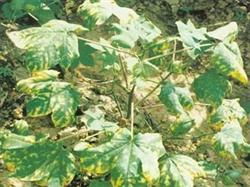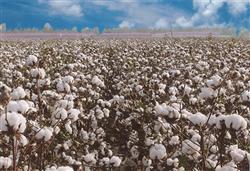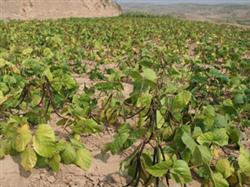Scientific Control of Cotton Fusarium Wilt and Verticillium Wilt

Fusarium wilt and Verticillium wilt are the main diseases affecting the high yield and efficiency of cotton. It is necessary to correctly identify the symptoms and take relative measures to improve the yield and quality and increase the benefit. 1. Fusarium wilt of cotton: the disease can occur in the cotyledon stage, and the first peak occurs in the budding stage. the symptoms of Fusarium wilt in the seedling stage are complex and diverse, which can be roughly divided into four types. 1. Yellow net pattern. The veins of young cotyledons or true leaves turn green, the mesophyll remains green, some or all of the leaves are yellow reticulate, and finally the leaves wither and fall off. 2. Yellowing type. Cotyledons or true leaves turn yellow, sometimes with local dead spots on the leaf margin. 3. Purplish red type. Cotyledons or true leaves turn purplish red or appear purple erythema. 4. Bacterial wilt type. Cotyledons or true leaves suddenly lose water, the color becomes slightly dark green, the leaves wither and die, sometimes the whole plant withered, and sometimes half of the plant withered. The appearance of each type varies with the change of environment, generally under the condition of suitable disease, especially in the case of greenhouse inoculation, most of them are yellow net pattern; in the case of drastic climate changes, such as rapid sunny after rain, more bacterial wilt type occurs. The typical symptom of cotton Fusarium wilt at budding stage is dwarf type, the diseased plant is characterized by short plant type, several nocturnal pathogens between main stem and fruit branches are significantly shortened and bent, the leaves are dark green, wrinkled and uneven, and the leaf margin curls slightly downward after increasing compared with normal leaves. sometimes some or all of the veins of the middle and lower leaves turn yellow into reticulation, and the vascular bundles of the affected parts also turn brown. Fusarium wilt can be transmitted through diseased seeds, diseased soil, diseased plant residues and cake fertilizer. Www.8658.cn eighth Route Venture Network 2. Verticillium wilt: under natural conditions, cotton gradually shows symptoms in the bud stage. Generally, the disease reaches its peak in the flowering and boll setting stage from July to August. The symptom is that the diseased plant begins to develop from the lower leaves, gradually develops upward, the edges of the diseased leaves curl slightly upward, and there are yellowish irregular patches between the veins, commonly known as "watermelon peel leaves", or even the whole leaf is scorched. Fall off into a smooth rod, sometimes in the base of the diseased plant or in the leaf axils of deciduous leaves, can send out superfluous buds and branches. Third, control measures 1. Select disease-resistant varieties. Disease-resistant varieties are the most direct and effective method to control wilt and wilt, which can be popularized by national agro-technical extension departments. 2. Soil testing and formula fertilization. Control the amount of fertilizer application according to soil nutrient content and cotton growth law, apply organic fertilizer, rational application of nitrogen, phosphorus and potassium elements and boron and other medium and trace element fertilizers, reduce crop deficiency and antagonistic syndrome, yellow, Fusarium wilt and other diseases and insect pests, and fertilizer diseases caused by excessive fertilization. From seedling stage to budding stage, it is necessary to apply less available nitrogen fertilizer and more slow-release calcium, magnesium, phosphorus and potassium fertilizer and organic matter fertilizer, accounting for about 10%-15% of the total fertilizer application; light and stable application of nitrogen, phosphorus and potassium fertilizer from bud to flowering stage, accounting for about 15%-20% of the total fertilizer application; heavy application of nitrogen, phosphorus and potassium fertilizer and organic matter fertilizer from flowering to jointing stage, accounting for about 60% of the total fertilizer application; from boll setting to boll opening stage, nitrogen fertilizer or cotton special compound fertilizer should be applied according to local conditions. 3. Crop rotation should be carried out. This method is an effective method to control Fusarium wilt and Verticillium wilt and avoid the favorable living environment brought by continuous cropping to pathogenic organisms. 4. symptomatic treatment with medicine. 300 × 500 times methyl potassium is used to control yellow and Fusarium wilt. Carbendazim 10g 15g, plus 40g "Luoxiaowang" foliar nutrient solution mixed, fully sprayed on the newly diagnosed cotton field; at the same time, use 600 to 700 times 80% bad mold? Fu 20g, that is, "Lvxiang plus 20g" multi-element foliar fertilizer directly drip irrigation root. In addition, we should also pay attention to timely sowing and timely removal of diseased plants in the cotton field.
- Prev

Integrated Control techniques of Cotton Diseases and insect pests
Topdressing is an important measure for cotton to set more bolls, set large bolls, reduce shedding and increase cotton yield. However, if topdressing is not scientific, it will not achieve the desired effect, and sometimes there will be side effects. In production, cotton topdressing has the following four points. First, topdressing according to the law of fertilizer demand. Different growth stages of cotton, to fertilizer.
- Next

Mung bean summer direct seeding technology
When mung bean seedlings reach 2 leaves and 1 heart, pimple seedlings should be removed. When 4 leaves are fixed, the plant spacing is 13 to 16 cm, the row spacing is about 40 cm, leaving 1 to 15000 seedlings per mu, and those who sow late can stay at most 20, 000 plants. Mung bean from emergence to flowering and sealing line, to adhere to diligent ploughing and weeding, generally not less than 4 times, mid-ploughing depth from shallow.
Related
- The first cup of black tea in spring, the flavor and history of tea gardens in Kenya, Africa
- The computer can not only choose potatoes, but also grow tea rice. AI will grow winter oolong tea champion.
- It is not only the inflated tea bitten by insects, but also engraved with the four seasons tea in Beipu.
- The Oriental Beauty Tea Festival in Zhuxian County takes the stage at the weekend to experience the plus-size feast of oil tea.
- & quot; Oriental Beauty Tea & Exploration of Emei in Hsinchu, the hometown of quot;
- The new variety of strawberry "Tainong 1" dessert is the first choice with mellow aroma. Crimson gorgeous
- History of Tea in Taiwan: from Wild Inner Mountain to Export Tea Garden
- Two types of Taiwan Oriental Beauty Black Tea won the British three-Star Award for Childhood Tea Xiang Zhang Jiaqi changed from pilot to champion tea maker.
- Banana species and varieties: the planting history of Taiwan Xianren banana and dwarf banana is long, is banana disease resistant?
- Coffee planting Technology: Qianjie Coffee from Seedling to harvesting

